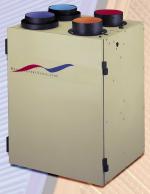Search engine visitors - click here to access entire "$ensible Home" web site
Click here to see a descriptive illustration showing designs of window or whole-house heat recovery ventilators and how they work.
Dear Jim: We made our house more airtight and efficient, but the air does not seem fresh or healthy indoors. Will installing a efficient whole-house model help very much? - Joyce B.

A: One drawback of making a house more energy efficient is the indoor air quality may suffer if you do not also make provisions for fresh air ventilation. An airtight home can result in a "stale air" feeling.
These systems are called heat recovery ventilators (HRV). There is a heat exchanger built into the unit. As stale heated air is exhausted outdoors, it passes through the heat exchanger. There, it transfers much of its heat energy (up to 80 percent on some models) to the incoming cold fresh air.
During the summer, the outgoing cooled stale air precools the incoming hot outdoor air. All the HRV models have effective air filters to remove particles and allergens before the fresh air enters your home.
The whole-house HRV models are usually mounted somewhere in the utility room, attic or basement near the furnace. These can be connected to your existing furnace duct system, but it is best to install its own ducting. The stale air inlets are often located in the kitchen and bathrooms and the fresh air outlets can be in a bedroom, living room or hallway.
A variation on an HRV is an ERV (energy recovery ventilator). An ERV also transfers the moisture between the outgoing stale air and the incoming fresh air along with the heat. This keeps the indoor air for becoming overly humid during the summer and they are more popular in hot, humid areas.
When selecting a HRV/ERV unit, consider the controls. These will impact its effectiveness, convenience and your family's comfort. Multiple speeds are a plus. This allow you to select a high speed for quick ventilation or a quiet slower speed for sleeping or continuous use.
The unit can have a simple timer or a more sophisticated control that measures the humidity or other pollutants in the indoor air to switch it on and off.
Instant Download Update Bulletin No. 993 - buyer's guide of 13 whole-house HRV and ERV manufacturers listing model numbers, air flow rate ranges, energy transfer efficiency ratings, type of heat exchanger design (enthalpic or just heat/cool), electric power consumption, unique features, prices, illustrations of models and a chart of common indoor air contaminants/problems.
Dear Jim: I am having a new roof installed on my house. While they are up there, I was thinking about having them install a chimney cap. Is it really worthwhile to install one over the fireplace chimney? - Bob M.
A: It probably is worthwhile to install one. It will keep animals from making nests in your chimney. Some raccoons made a summer nest in my mother's chimney and fleas dropped from them and got into her house.
Another benefit of a chimney cap is to keep sparks from escaping from the chimney. This is a potential source of a house fire. Chimney caps also keep the rain out of the chimney. Get one large enough to cover the entire chimney top.